Ancient Trees
10 September - 13 October 2024
Gloucester
PV 10 September
This exhibition is a unique collaboration between The Arborealists and Julian Hight, celebrated authority on ancient trees and author of Britain’s Tree Story among others.
Ancient Trees of Britain
Britain is one of the least forested countries in northern Europe, but boasts the highest number of ancient trees. What we lack in woodland cover is almost made up for by the historical value of these sylvan beasts. Some may have stood for over a thousand years. Some British Yew trees are reputed to be up to four times that age, which if true, makes them the oldest living trees in Europe.
From a human perspective, it is their constant presence within the community, surviving through one generation to the next and carrying with them events and stories, that elevates ancient trees to a higher place in our psyche. Over the centuries people have revered and named them. They act as silent witnesses to our colourful history, and such is their longevity that some could be only ten generations away from the end of the last ice age when they first colonised our islands, spreading north from mainland Europe as the ice receded.
Pinning an age on Britain’s ancient trees is problematic. Without a known planting date, the only way to calculate age is to count annual growth rings. All of Britain’s native tree species decay and hollow with age, shedding surplus heartwood to fungi and beetles – a mutually beneficial partnership creating hotspots for biodiversity, providing compost for the tree itself. Oak leads the way, offering habitat to at least 500 species – more than any other British tree – with around 120 individuals standing over 9 metres in circumference, with some estimated to be around 1,000 years old. While sometimes disputed, archive photographs and artwork from the Victorian era offer supporting evidence through visual dating, where trees often show little change in shape and character in over a century, lending credence to the old adage often applied to Oaks; “300 years young, 300 more mature, 300 in decay.”
By capturing ancient trees in works of art, we are effectively contributing to the story – a representation of where they are today, set down as chronicles for the future.
The exhibition is art and history entwined and will be enhanced by multiple elements:
The individual stories of the trees including facts, myths and folklore, many are connected to a variety of fascinating historical events.
Their appearance today, interpreted through contemporary artists’ eyes, in their works of art of diverse scale, media, style and technique.
People are fascinated how ancient trees, like any living entity, appear (or not) to change in structure and health over time, and the contemporary works of art will be partnered with 100 year-old postcards and photographs to engender an understanding of their extraordinary life-span and survival strategies as well as their living history benefits to humanity.
The exhibition will present two distinct elements:
Artists will make and present one work selected from a list of around 12 ancient trees compiled by Julian Hight, of substantial geographical spread across the middle and south of England, of a diverse range of species, appearance and history. These will be hung in same-tree groups accompanied by Julian Hight’s insightful, interpretive texts.
Artists will select, make and exhibit a work of an ancient tree of their choice and these will be hung together, interpreted with their own texts that weave a personal connection with the story of the tree.
